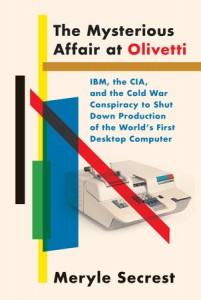IBM, the CIA, and the Cold War Conspiracy to Shut Down Production
of the World’s First Desktop Computer
By Meryle Secrest
Penguin Random House
Disponibile dal 5 Novembre 2019 in USA in formato libro cartonato, e-book, Audiobook.
Introduction
The never-before-told true account of the design and development of the first desktop computer by the world’s most famous high-styled typewriter company, more than a decade before the arrival of the Osborne 1, the Apple 1, the first Intel microprocessor, and IBM’s PC5150.
The human, business, design, engineering, cold war, and tech story of how the Olivetti company came to be, how it survived two world wars and brought a ravaged Italy back to life, how after it mastered the typewriter business with the famous “Olivetti touch,” it entered the new, fierce electronics race; how its first desktop computer, the P101, came to be; how, within eighteen months, it had caught up with, and surpassed, IBM, the American giant that by then had become an arm of the American government, developing advanced weapon systems; Olivetti putting its own mainframe computer on the market with its desktop prototype, selling 40,000 units, including to NASA for its lunar landings.
How Olivetti made inroads into the US market by taking control of Underwood of Hartford CT as an assembly plant for Olivetti’s own typewriters and future miniaturized personal computers; how a week after Olivetti purchased Underwood, the US government filed an antitrust suit to try to stop it; how Adriano Olivetti, the legendary idealist, socialist, visionary, heir to the company founded by his father, built the company into a fantastical dynasty–factories, offices, satellite buildings spread over more than fifty acres–while on a train headed for Switzerland in 1960 for supposed meetings and then to Hartford, never arrived, dying suddenly of a heart attack at fifty-eight . . . how eighteen months later, his brilliant young engineer, who had assembled Olivetti’s superb team of electronic engineers, was killed, as well, in a suspicious car crash, and how the Olivetti company and the P101 came to its insidious and shocking end.

Un nuovo corposo libro, questa volta in inglese, sulla storia della Olivetti, di una scrittrice anglosassone che vive però a Washington. In attesa di leggere il testo possiamo intuire che l’autrice riprenda il tema del complotto americano contro Adriano e l’azienda, già adombrato nella fiction prodotta nel 2013 da Luca Barbareschi per la RAI, con Luca Zingaretti nelle vesti del protagonista. Tema affrontato successivamente e mai chiarito. Si veda ad esempio qui (RAI), qui (Corriere) e qui (CDB)
Quache novità da oltre Atlantico? Staremo a vedere.
A fascinating history of the Company and the key, visionary figures responsible for the Company’s creation and amazing business and technological growth. As someone who spent two years in Ivrea, the book generated considerable nostalgia, especially since I was previously a P101 salesman. The speculative ending raises some interesting questions but, without anything but circumstantial evidence, the questions remain open.
One last point: the author describes La Battaglia delle Arance and says the origin of oranges as a weapon is unknown. I recall that local legend says that the oranges represent cobble stones which were dug up by the citizens of the town and used to overwhelm the feudal lord’s army.
Letto da cima a fondo e rilette alcune parti relative agli anni 55-65, le più rilevanti per la nascita dell’elettronica olivettiana (Elea 9003 e P101).
Sono 280 pagine di storia della famiglia Olivetti e dell’azienda. L’autrice ha passato molto tempo in Italia e ha intervistato molti testimoni dell’epoca. Il libro è ben scritto e documentato; il suo merito maggiore è il contributo che può fornire a far conoscere Olivetti al mondo dei lettori anglosassoni.
Tuttavia, il titolo mi sembra fuorviante, come capita spesso nei romanzi. La “Conspiracy” compare solo verso la fine e, come già per altri testi italiani sulla vicenda olivettiana, il giallo non svela chi sia stato l’assassino ….
(a mio modesto parere gli assassini sono stati molti, e il morto non si chiama né Adriano né Mario, ma più semplicemente Ing. C. Olivetti & C. S.p.A.)